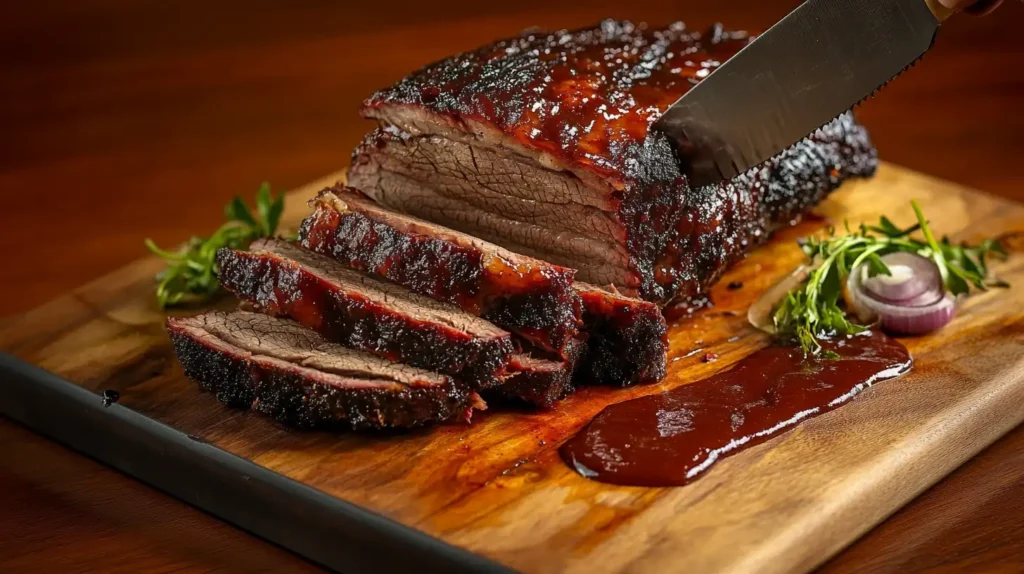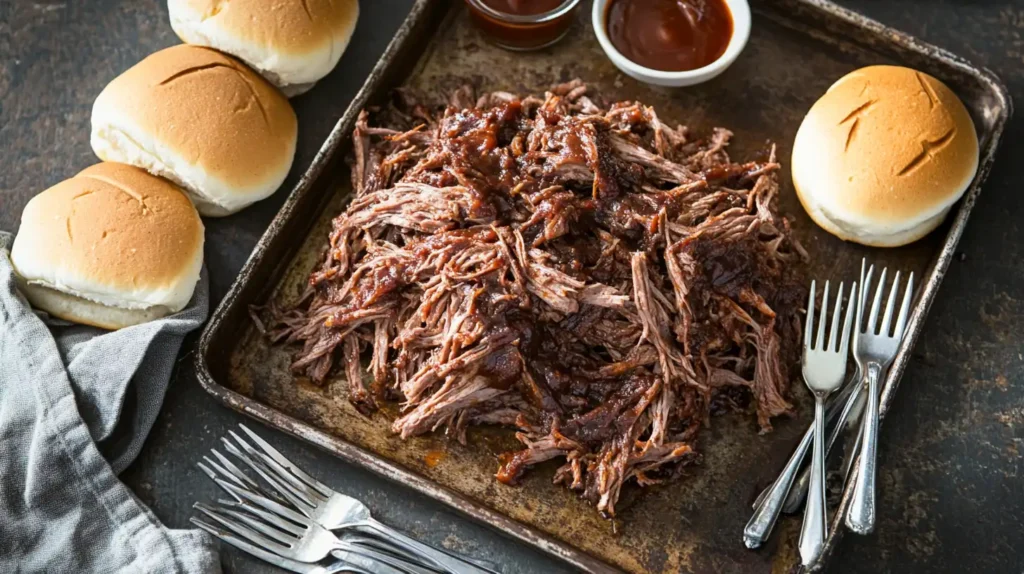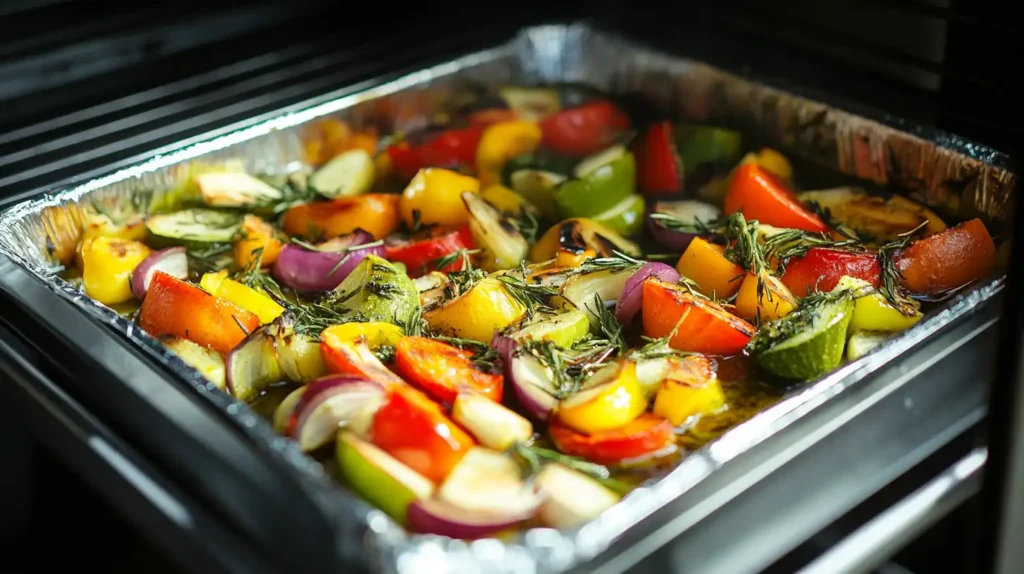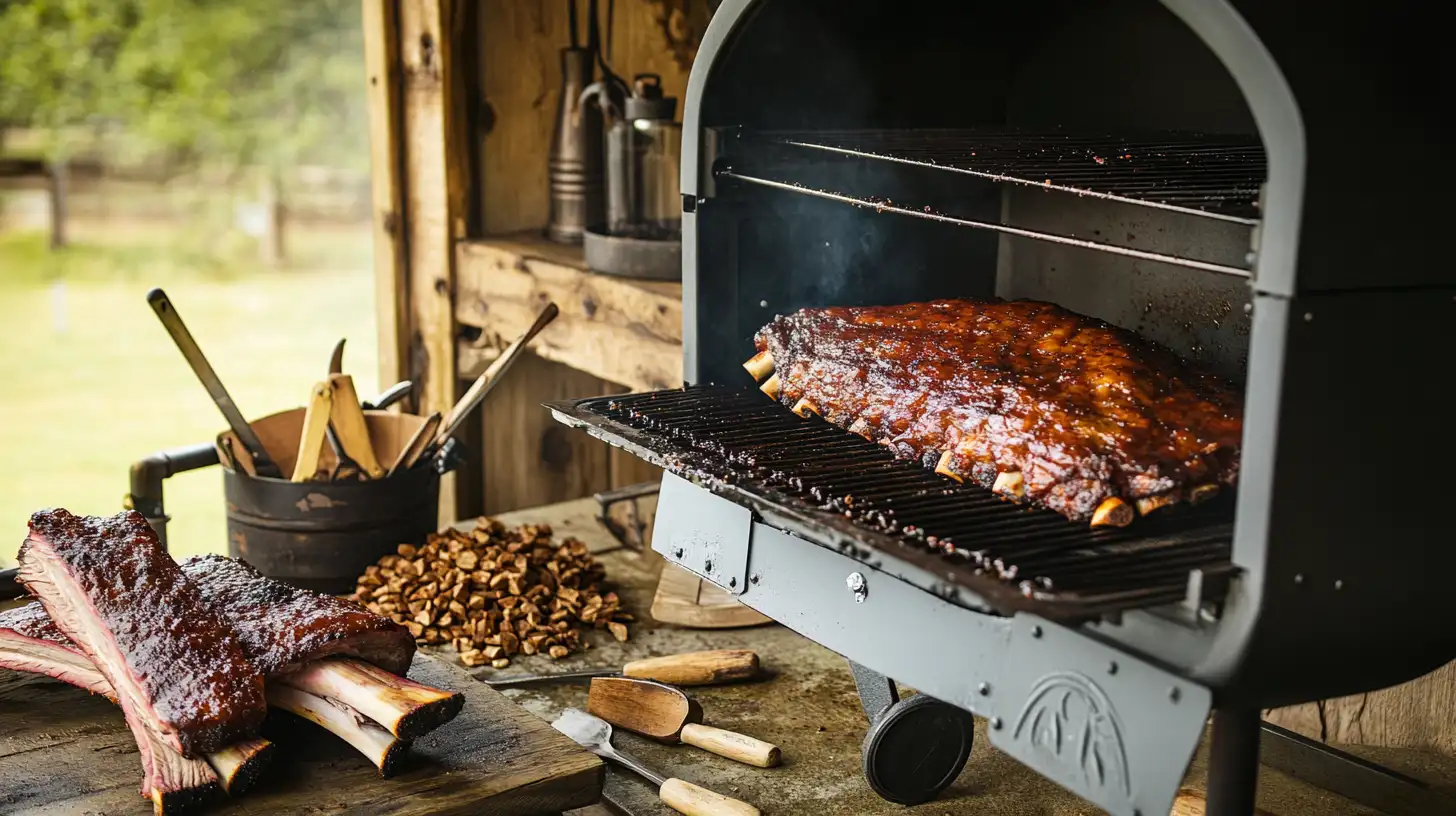Introduction
Smoker recipes are a must-try for anyone who loves bold, rich flavors in their food. Whether you’re a seasoned pitmaster or a curious beginner, using a smoker unlocks a whole new world of culinary possibilities. From classic smoked brisket recipes to creative smoked desserts, these dishes bring depth and complexity to your cooking that other methods simply can’t replicate.
In this guide, you’ll discover a variety of smoker recipes perfect for meats, vegetables, and even desserts. With step-by-step instructions and helpful tips, you’ll learn how to create dishes that are not only delicious but also easy to make. Whether you’re hosting a barbecue or treating your family to a special dinner, these smoker recipes will elevate your cooking to new heights.
Understanding the Basics
Choosing the Right Smoker for Your Needs
Before diving into smoker recipes, it’s important to choose the right smoker for your cooking style. Smokers come in different types, each with unique benefits:
- Charcoal Smokers: These are perfect for barbecue lovers who want authentic smoky flavors. They need more hands-on attention but deliver exceptional taste.
- Electric Smokers: Ideal for beginners, electric smokers offer consistent temperatures and easy operation. They are great for low-maintenance smoking.
- Gas Smokers: These smokers use propane or natural gas. They heat up quickly and maintain steady temperatures, offering a balance between flavor and convenience.
- Pellet Smokers: Pellet smokers are versatile. They use wood pellets as fuel, combining smoky flavor with the ease of electric controls.
When choosing a smoker, think about the recipes you’ll make, the space available, and how involved you want to be in the process.
Essential Tools and Ingredients for Smoking
To make the most of your smoker, you’ll need a few essential tools and ingredients:
- Thermometer: A reliable meat thermometer helps you monitor food temperatures to ensure perfect results.
- Wood Chips: The wood you use greatly affects flavor. Hickory adds strong, smoky notes. Applewood creates a sweeter taste, while mesquite offers bold, earthy flavors.
- Drip Pan: A drip pan catches juices and keeps the smoker moist. This prevents food from drying out during the cooking process.
- Marinades and Rubs: Use flavorful marinades or spice rubs to enhance taste and help the smoke penetrate the meat or vegetables evenly.
- Aluminum Foil or Butcher Paper: Wrapping food retains moisture and prevents over-smoking during long cooking sessions.
With the right smoker, tools, and ingredients, you’ll be set to create dishes full of rich, smoky flavor that everyone will love.
Top Smoker Recipes
Smoked Brisket Recipe: A BBQ Classic
Smoked brisket is a timeless favorite for barbecue lovers. The slow smoking process breaks down the tough connective tissues, resulting in tender, juicy meat packed with smoky flavor. To get started:
- Prep the Meat: Trim excess fat from the brisket and apply a generous rub of salt, pepper, paprika, and garlic powder.
- Smoking Tips: Set your smoker to 225°F (107°C) and smoke the brisket low and slow. Use hickory or oak wood for a deep, smoky flavor.
- Cook Time: Smoke for 1 to 1.5 hours per pound of meat. Wrap the brisket in butcher paper halfway through cooking to retain moisture.

Let the brisket rest for at least 30 minutes before slicing to ensure the juices are evenly distributed.
Smoked Beef Ribs: A Juicy and Flavorful Treat
Smoked beef ribs are a barbecue classic that delivers bold, meaty flavor with a tender, smoky finish. They’re perfect for impressing guests or indulging in a hearty meal. Here’s how to get started:
- Prep the Ribs: Begin by removing the silver skin from the back of the ribs for better seasoning absorption. Generously coat the ribs with a dry rub made from salt, black pepper, smoked paprika, garlic powder, and cayenne for a little heat.
- Smoking Tips: Set your smoker to 250°F (121°C) and use oak or hickory wood for a robust smoky flavor. Arrange the ribs bone-side down on the smoker grates.
- Cook Time: Smoke the ribs for 5–6 hours, spritzing them with a mixture of apple cider vinegar and water every hour to keep them moist. Wrap the ribs in butcher paper for the last 1–2 hours to retain juiciness.

Once the ribs reach an internal temperature of 203°F (95°C), let them rest for 20–30 minutes before slicing. Serve with your favorite barbecue sauce or enjoy them plain—the smoky flavor speaks for itself! ks and toss it in your favorite barbecue sauce for a mouthwatering dish.
Smoked Chicken: Perfect for Family Meals
Smoked chicken is versatile and a lighter option for smoking enthusiasts. It’s great for salads, sandwiches, or as a main dish:
- Prep the Chicken: Brine the chicken for 2–4 hours in a mixture of water, salt, sugar, and spices. This helps keep the meat juicy.
- Smoking Tips: Set your smoker to 225°F (107°C). Use cherry wood or pecan wood for a mild, sweet flavor that enhances poultry.
- Cook Time: Smoke until the internal temperature reaches 165°F (74°C). This typically takes about 3–4 hours for a whole chicken.
Brush the chicken with a glaze of honey or barbecue sauce during the last 30 minutes for an extra layer of flavor.
Smoked Salmon: Elegant and Healthy
Smoked salmon is a sophisticated dish that’s surprisingly simple to prepare. It’s perfect for brunch spreads or light dinners:
- Prep the Fish: Create a dry brine with equal parts salt and brown sugar. Coat the salmon fillet and let it cure in the fridge for 6–8 hours.
- Smoking Tips: Set your smoker to 180°F (82°C). Use alder or applewood for a light, fruity smoke flavor.
- Cook Time: Smoke the salmon for 2–3 hours or until it flakes easily with a fork.
Serve the smoked salmon with cream cheese, capers, and crackers for a delicious presentation.
Smoked Vegetables and Desserts
Smoked Vegetables: A Plant-Based Delight
Smoked vegetables are an excellent choice for anyone looking to add a healthy, flavorful side to their meal. Not only does Smoking brings out the natural sweetness of vegetables, making smoked vegetable recipes a great addition to any meal. Here are some popular options to try:
- Bell Peppers and Zucchini: Slice into thick strips, then brush with olive oil and season lightly with salt and pepper. When smoked at 225°F (107°C) for about 45 minutes, they become tender and full of flavor.
- Sweet Potatoes: Cut into wedges and toss with olive oil, adding a dash of smoked paprika for an extra kick. After smoking at 250°F (121°C) for 2 hours, the wedges will be caramelized and deliciously soft.
- Asparagus: For a quick side, brush with olive oil and garlic powder, then smoke at 225°F (107°C) for just 30 minutes. This method enhances the natural flavor and makes a perfect pairing with grilled proteins.

Beyond being a healthy side dish, smoked vegetable recipes are versatile enough to work in salads, grain bowls, or even as a main dish. You can toss them into salads, mix them with grains, or serve them drizzled with balsamic glaze for an elegant finish.
Smoked Dessert Recipes: Sweet Treats with a Smoky Twist
Did you know you can also smoke desserts? Adding a touch of smokiness to sweet dishes creates an unexpected yet delightful flavor profile. These ideas are great for surprising your guests:
- Cheesecake: Prepare your favorite cheesecake recipe in a springform pan. Smoking it at 250°F (121°C) with a mild wood like cherry for 1–2 hours gives it a subtle, smoky edge while keeping the texture rich and creamy.
- Pineapple: Fresh pineapple slices sprinkled with brown sugar transform into caramelized perfection when smoked at 225°F (107°C) for 1 hour. Pair them with vanilla ice cream for a tropical dessert with a twist.
- Chocolate Brownies: Bake your brownies in a smoker-safe dish at 300°F (149°C) for 30–40 minutes. The smoky undertones enhance the rich chocolate flavor, making them irresistible.
Adding smoked desserts to your repertoire is not only fun but also an excellent way to showcase the versatility of your smoker. With a little creativity, these treats will leave everyone impressed.
Expert Tips for Perfect Smoker Recipes
Controlling Temperature and Smoke Levels
Mastering temperature and smoke control is essential for achieving great results with your smoker. First, always preheat your smoker to the recommended temperature before adding food. This step ensures that the cooking process starts evenly and produces consistent results. Furthermore, using a thermometer to monitor both the smoker’s internal temperature and the food itself is crucial to avoid undercooking or overcooking.
When it comes to smoke levels, less is often more. A steady stream of thin, blue smoke provides better flavor compared to thick, white smoke, which can turn food bitter. To achieve this, avoid adding too many wood chips or chunks at once. Instead, add them gradually throughout the cooking process. Additionally, maintaining a clean smoker and proper airflow helps create balanced smoke levels for a richer flavor. The Crab Brulee Recipe is an excellent choice for exploring how subtle smoke enhances seafood.
Experimenting with Wood Chips for Unique Flavors
The type of wood you use significantly affects the flavor of your smoked dishes. For example, hickory adds a bold, smoky taste that works wonderfully with red meats, while applewood creates a subtle, fruity sweetness that enhances poultry and pork. Similarly, mesquite brings an earthy intensity, making it ideal for beef or game meats. By mixing woods, you can create your own signature flavor profile. For instance, combining mesquite with cherrywood balances boldness and sweetness beautifully.
Moreover, soaking your wood chips in water, juice, or even beer before use can add an extra layer of flavor. This technique slows down burning and allows the smoke to infuse deeper into the food. As you gain confidence, feel free to experiment with different woods and soaking methods to discover what works best for your recipes. Combine this tip with the Rockfish Recipes for delicious results.
Prepping Meat and Veggies for Best Results
Proper preparation is the foundation of successful smoking. For meats, trimming excess fat not only prevents flare-ups but also helps the meat cook more evenly. Additionally, applying a marinade, brine, or spice rub in advance enhances flavor and tenderizes the meat. When working with vegetables, lightly coating them in olive oil and seasoning them thoroughly ensures they stay moist and flavorful during the smoking process.
Timing is another key factor. Always let your meat or veggies rest at room temperature for 20–30 minutes before placing them in the smoker. This step helps them absorb the smoke more effectively and cook evenly. Finally, remember that smoking is a slow process. Patience is essential, as rushing through it can compromise the flavors and textures you’re aiming for. Allow the smoke to work its magic, and you’ll be rewarded with dishes full of rich, smoky goodness.
Smoker Recipe FAQs: Common Questions Answered
Can You Smoke Foods Without a Smoker?
Yes, you can smoke foods even if you don’t own a traditional smoker! One popular method is to use a grill. By setting up a two-zone fire—where one side is hot, and the other is cooler—you can place wood chips on the hot side and food on the cool side to achieve that smoky flavor. Additionally, stovetop smokers are a great option for smaller items like fish or vegetables.
If you prefer a simpler approach, try adding liquid smoke to marinades or sauces. While it’s not the same as traditional smoking, it adds a hint of that distinctive flavor. These methods are convenient alternatives for those who don’t have a dedicated smoker but still want to enjoy smoky goodness.
What Are the Best Woods for Smoker Recipes?
The best wood depends on what you’re cooking and the flavor profile you want to achieve. For example:
- Hickory: Great for pork and ribs, it offers a strong, smoky flavor with a hint of sweetness.
- Applewood: Ideal for poultry, pork, and fish, it provides a mild, fruity flavor.
- Cherrywood: Adds a slightly sweet, fruity taste that pairs well with beef and game meats.
- Mesquite: Best for beef and game meats, it’s bold and earthy but should be used sparingly to avoid overpowering the dish.
- Pecan: Offers a sweet, nutty flavor that works well with poultry and desserts.
Mixing different woods can also create unique flavors. Experiment with combinations to find what works best for your recipes!
How Long Should Foods Be Smoked for Smoker Recipes?
The smoking time varies based on the type of food, the size of the cuts, and the smoker’s temperature. For example:
- Brisket: Smoke at 225°F (107°C) for 1–1.5 hours per pound.
- Pulled Pork: Smoke at 250°F (121°C) for 8–10 hours or until the internal temperature reaches 195°F (90°C).
- Chicken: Smoke at 225°F (107°C) for 3–4 hours until the internal temperature hits 165°F (74°C).
- Vegetables: Smoking times vary but typically range from 30 minutes to 2 hours depending on the type.
- Fish: Smoke at 180°F (82°C) for 2–3 hours or until it flakes easily with a fork.
Always use a meat thermometer to check doneness, as internal temperature is the best indicator of when food is ready to serve.
Can You Smoke Desserts or Cheese?
Absolutely! Smoked desserts and cheeses are delightful and surprisingly easy to make. For desserts, options like smoked cheesecake or brownies introduce a subtle, smoky complexity that enhances their sweetness. Similarly, smoking cheese at a low temperature (under 90°F/32°C) ensures it absorbs the smoky flavor without melting. Cold smoking is ideal for cheeses like cheddar, gouda, or mozzarella.
Both smoked desserts and cheeses are unique additions to any meal and are sure to impress your family and friends.
Conclusion
Smoker recipes open the door to an exciting world of bold, smoky flavors. From hearty smoked brisket recipes to healthier smoked vegetable recipes, the variety of dishes you can create is endless. With the right techniques and a bit of patience, your smoker will become the star of your kitchen or backyard.
By following this guide, you’ll gain the confidence to experiment with new smoker recipes and wow your friends and family. Whether it’s a weekend barbecue, a weeknight dinner, or even dessert, there’s always room for a delicious smoked dish. So, fire up your smoker and get ready to enjoy the rich, smoky flavors of these incredible recipes!

